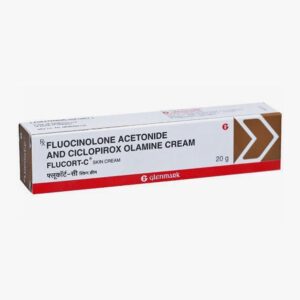CICLOPIROX OLAMINE + FLUOCINOLONE
Ciclopirox Olamine: Ciclopirox Olamine is an antifungal medication used to treat various fungal infections of the skin and nails. It is available as a cream, gel, or nail lacquer.
The mechanism of action of Ciclopirox Olamine involves inhibiting the synthesis of essential components of the fungal cell membrane, which leads to disruption of cell membrane integrity and ultimately kills the fungus.
The recommended dose and duration of treatment may vary depending on the type and severity of the infection. It is important to follow the instructions provided by your healthcare provider or the product label.
Common side effects of Ciclopirox Olamine include skin irritation, burning, redness, dryness, itching, or stinging at the application site. These side effects are generally mild and temporary. If these symptoms persist or worsen, it is advisable to consult a healthcare professional.
Rarely, serious allergic reactions may occur. If you experience symptoms such as rash, itching, swelling, severe dizziness, or difficulty breathing, seek immediate medical attention.
It is worth noting that Ciclopirox Olamine may interact with other medications, so it’s important to inform your healthcare provider about all the drugs you are taking.
Overall, Ciclopirox Olamine is a commonly prescribed antifungal agent used for the treatment of fungal infections of the skin and nails. It effectively targets the fungus, providing relief from symptoms and promoting healing.
Fluocinolone: Fluocinolone is a corticosteroid medication with anti-inflammatory and immunosuppressive properties. It is primarily used to treat various skin conditions, including eczema, dermatitis, psoriasis, and allergic reactions.
The mechanism of action of fluocinolone involves its ability to bind to glucocorticoid receptors on cells, leading to decreased inflammation and immune response. It inhibits the production of inflammatory mediators, such as prostaglandins and leukotrienes, and reduces the infiltration of immune cells into the affected area.
Fluocinolone is available in various forms, including creams, ointments, solutions, and scalp oil. The exact dosage and frequency of use depend on the specific condition being treated and the formulation being used. It is usually applied to the affected areas of the skin once or twice daily.
Common side effects of fluocinolone may include skin irritation, burning, itching, dryness, or redness at the application site. Prolonged or excessive use of fluocinolone can lead to skin thinning, stretch marks, or discoloration. In rare cases, systemic absorption of the medication can occur, leading to side effects such as adrenal suppression, high blood sugar levels, or Cushing’s syndrome. It is important to follow the prescribed dose and duration of treatment to minimize the risk of these side effects.
Fluocinolone should not be used on open wounds, infected areas, or near the eyes. It should also be used with caution in children, pregnant or breastfeeding women, and individuals with certain medical conditions, such as diabetes or compromised immune function.
As with any medication, it is important to consult a healthcare professional for proper diagnosis, dosage, and guidance on the use of fluocinolone.

